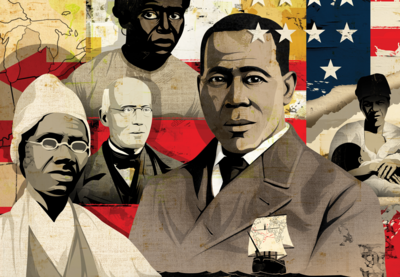In these short streaming films, aligned with the Teaching Hard History: American Slavery framework, historians and scholars explore the undertaught history of African and Indigenous enslavement, explain critical concepts, and share recovered narratives that can help students better understand the individual and collective impact—and the damaging legacy—of hundreds of years of American slavery.
The Forgotten Slavery of Our Ancestors
The Forgotten Slavery of Our Ancestors offers an introduction to the history of Indigenous enslavement on land that is now the United States. As the featured historians point out, the enslavement of Indigenous peoples stretched from Alaska into South America. It predated and helped shape the system of African enslavement in New England, and it lasted until throughout the 19th century in the West. “This,” explains historian Andrés Reséndez, “is our shared history.”
Directed and edited by Howdice Brown III, The Forgotten Slavery of Our Ancestors was produced by Marie Acemah and Alice Qannik Glenn. The runtime for this film is just over 12 minutes.
Key Concept Videos
In each Key Concept video, a scholar or historian explores one of 10 central ideas that serve as the foundation for Teaching Hard History: A Framework for Teaching American Slavery. These short videos help students understand concepts like the critical role slavery and the slave trade played in the early American economy and the revolutionary and everyday resistance of enslaved people to a system that would dehumanize them. Whether watched individually or in sequence, these videos offer ways for students to better understand the nation’s development around slavery, that institution’s impact on the lives of enslaved people, and the countless ways that enslaved people influenced the culture and history of what is now the United States.
Key Concept 1
Slavery, which Europeans practiced before they invaded the Americas, was important to all colonial powers and existed in all North American colonies.
Historian Ibram X. Kendi uses the case of Elizabeth Key to trace how Virginians changed British law to protect the growing institution of slavery in the 17th century.
Key Concept 2
Slavery and the slave trade were central to the development and growth of the colonial economies and what is now the United States.
Historian Adam Rothman traces how the labor of enslaved people in an area just outside New Orleans rippled across the globe to create wealth for the growing nation.
Key Concept 3
Protections for slavery were embedded in the founding documents; enslavers dominated the federal government, Supreme Court and Senate from 1787 through 1860.
Scholar Annette Gordon-Reed explores how the Constitution, written when slavery was seen as a “dying institution,” actually protected the institution and allowed enslavers to aggressively defend its expansion.
Key Concept 4
“Slavery was an institution of power,” designed to create profit for the enslavers and break the will of the enslaved and was a relentless quest for profit abetted by racism.
Historian Daina Ramey Berry describes the sale of an infant named Rachel to explore how enslaved people were commodified.
Key Concept 5
Enslaved people resisted the efforts of their enslavers to reduce them to commodities in both revolutionary and everyday ways.
Historian Tera Hunter discusses Henry “Box” Brown’s escape from slavery and his work as an abolitionist.
Key Concept 6
The experience of slavery varied depending on time, location, crop, labor performed, size of slaveholding and gender.
Historian Edward L. Ayers describes how the age and gender of enslaved people, along with the labor needs in different parts of the country, affected the domestic slave trade.
Key Concept 7
Slavery was the central cause of the Civil War.
Scholar Christy Coleman discusses the importance of slavery to the economies of Southern and Northern states, its central role in leading to the Civil War and ensuing myths about that role.
Key Concept 8
Slavery shaped the fundamental beliefs of Americans about race and whiteness, and white supremacy was both a product and legacy of slavery.
Historian Martha Jones traces the development of racist ideas about people of African descent from the colonial period through the early 19th century.
Key Concept 9
Enslaved and freed people worked to maintain cultural traditions while building new ones that sustain communities and impact the larger world.
Historian Ibram X. Kendi discusses how the foodways and music of enslaved Africans helped shape American culture as we know it today.
Key Concept 10
By knowing how to read and interpret the sources that tell the story of American slavery, we gain insight into some of what enslaving and enslaved Americans aspired to, created, thought and desired.
Scholar Annette Gordon-Reed discusses the challenges of using texts created by enslavers to understand the lives of enslaved people.
